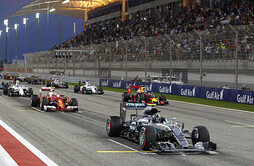 Starts have been a big talking point after the first couple of races. What is the main challenge for teams when it comes to making a clean getaway?
Starts have been a big talking point after the first couple of races. What is the main challenge for teams when it comes to making a clean getaway?
Ever since standing starts were implemented in Formula One, they have been extremely variable. The big challenge for teams is not simply to have the best starts on the grid - but to reduce that variability as much as possible.
How does the team measure a race start? And who has fared best thus far in 2016?
At Mercedes, we measure a race start in terms of distance covered in the first four seconds. Most teams will use a similar metric. According to that metric, on average, the Silver Arrows had the best starts on the grid in 2015. The problem is that, despite a strong average, variability meant that several of those starts were poor and resulted in a loss of position. Of the two races so far in 2016, Nico had the sixth best start on the grid in Melbourne - and the best in Bahrain. Conversely, of the five drivers who got a better launch than Nico in Melbourne, four were the worst starters in Bahrain - the exception being Vettel, who didn't take the start at all. So, taking this sample of two races, you couldn't have a better illustration of that variability. The best start in Melbourne was actually Pascal Wehrlein - a rookie on his Grand Prix debut, driving for the second least-experienced team on the grid!
What is the most challenging aspect of a race start inside the cockpit?
One of the main challenges for the drivers comes in the mid-phase of the launch, when they're controlling the torque before reaching the power-limited phase. The team can help to a limited extent with the clutch, which controls the initial phase of the getaway. But once they drop the clutch, in the mid-phase, the driver is trying to balance on a pinnacle of perfect tyre slip. Drop one way, and they've got wheel spin. Drop the other, and they're bogging down. With all the noise and activity of the other cars around them at this point, it's very tricky to resolve the difference.
Rules governing clutch configurations have recently been amended. How big an impact has this had?
Variability has been deliberately increased by restrictions introduced during 2015 and extended for 2016. These restrictions have forced race starts to be more fully controlled by the driver himself, making them as close to fully 'manual' as possible. To be more specific, the team cannot instruct or coach the driver via radio communication - and the driver must control the clutch manually with only one lever. Performance now depends more than ever on driver skill - but not entirely. It is still up to the team to provide powerful and consistent equipment. This has added an extra dimension to the task at hand for all parties concerned, so it should come as no surprise to see even more variation across the grid this season.
So have the changes to the regulations achieved their objective?
These regulations have been introduced to make races more unpredictable. If race starts are more variable, then more drivers will find themselves out of position relative to their grid position and more interesting races will result. This is what happened in Melbourne and Bahrain, so the conclusion can reasonably be made that the regulations have been successful thus far. If "mixed-up grids" are the objective, then this is a much fairer way to achieve it, since the result is ultimately still achieved on the merit of team and driver. A more complete conclusion can be formed after half a season with a settled set of regulations.
Can the teams take measures to counter the variability of race starts?
Whatever the regulations might be, variability is simply part of the nature of race starts. It's something that, despite decades of intensive research, development and practice, nobody has perfected. As a sport, Formula One has achieved a lot of very difficult and impressive things over the years, so if the entire technical competence of the paddock has failed to crack it, it must be pretty difficult!
So, it's a case of accepting the inevitable and focusing on other things, then?
Teams will never give up the fight when it comes to a technical challenge. Everyone is constantly looking to improve - and there will be lessons learned from the first two races under these new rules that will have kicked off that process already. There doesn't seem to be a magic solution on the horizon that will simply eliminate variability. But the real question is whether that's necessarily a bad thing. On the basis of the first lap entertainment in Melbourne and Bahrain, one could argue it makes for a better spectacle...






















sign in